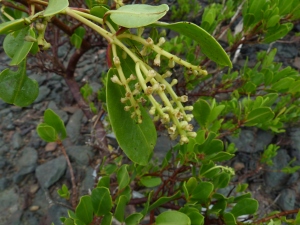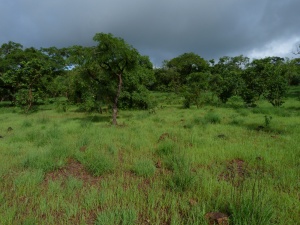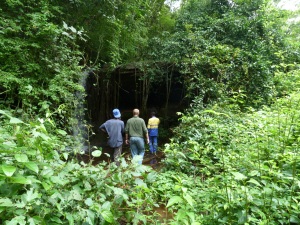Trip to the Republic of Guinea – Day Four
Took a pre-breakfast walk down to the mangroves at the mouth of the river. Overcast and windy conditions meant that not many birds were to be seen. Red-chested Swallows were regularly seen overhead, and both Green-backed Heron and Pied Kingfisher were present in the mangroves. All three of the common mangrove trees were in flower, namely Rhizophora mangle, Avicennia germinans and Laguncularia racemosa, giving me a good opportunity to get aquainted with them.  A basic breakfast at the hotel was followed by a drive back up the road to the AluFer camp, where we met up with the Okapi team. The plan was to visit key sites in the project area and get a feel for the issues that need to be dealt with. We started at Kalikali, the northernmost hill in the tenement. The site is characterised by open grassland on laterite, surrounded by closed woodland which is characterised by trees such as Parkia biglobosa, Pterocarpus erinaceus and Lannea species.
A basic breakfast at the hotel was followed by a drive back up the road to the AluFer camp, where we met up with the Okapi team. The plan was to visit key sites in the project area and get a feel for the issues that need to be dealt with. We started at Kalikali, the northernmost hill in the tenement. The site is characterised by open grassland on laterite, surrounded by closed woodland which is characterised by trees such as Parkia biglobosa, Pterocarpus erinaceus and Lannea species.  A small non-perennial stream runs through the centre of the grassland and feeds a small patch of gallery forest. From there we moved to another one of the hills in the centre of the project area, and then it was on to Cape Verga at the coast. This rocky promontory is covered with treacherously slippery green algae and we needed to take care walking across the rocks. A small grove of Rhizophora mangrove trees has established on the rocks, and another mangrove species, Conocarpus erectus, was found.
A small non-perennial stream runs through the centre of the grassland and feeds a small patch of gallery forest. From there we moved to another one of the hills in the centre of the project area, and then it was on to Cape Verga at the coast. This rocky promontory is covered with treacherously slippery green algae and we needed to take care walking across the rocks. A small grove of Rhizophora mangrove trees has established on the rocks, and another mangrove species, Conocarpus erectus, was found.  We then drove back to the AluFer camp for a late lunch, after which we decided to try and find one of the sacred forests in order to get an idea of the biodiversity value of these relic forests.
We then drove back to the AluFer camp for a late lunch, after which we decided to try and find one of the sacred forests in order to get an idea of the biodiversity value of these relic forests.
We drove to Damouya Sacred Forest, hoping to just get to see the edge of the forest but realising that the chance of being able to enter the forest was unlikely. Imagine our suprise when some of the local community members who were planting rice at the edge of the forest offered to take us in to the forest and show us a cave site! Ecstatic we quickly agreed and followed two of them into the tall forest. A short walk down to the forested stream revealed a small waterfall over a rock ledge and under the ledge was a deep overhang which could ostensibly be called a cave.  I was hoping to find evidence of nesting Picathartes, a rare and secretive bizarre bird that nests in forested caves, but was unsuccessful. However, the locals said that birds do use this cave, so it could still be possible! We were not allowed much time in the forest and had to leave after a few minutes at the cave. Even that short time was worth it and I was overjoyed – definitely a highlight of this trip. That was it for the day and we headed back to camp.
I was hoping to find evidence of nesting Picathartes, a rare and secretive bizarre bird that nests in forested caves, but was unsuccessful. However, the locals said that birds do use this cave, so it could still be possible! We were not allowed much time in the forest and had to leave after a few minutes at the cave. Even that short time was worth it and I was overjoyed – definitely a highlight of this trip. That was it for the day and we headed back to camp.